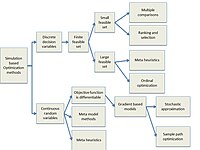Simulation-based optimization

Okay kiddo, imagine you have a huge maze, and you want to find the quickest way through it. But you can't just walk through it and try different paths, it's too big and complicated for that. So what do you do?
You could use a computer to make a simulation of the maze. This means the computer creates a virtual version of the maze and makes a little person like you walk through it. The computer can try different paths and see which is the quickest.
But it's not just about finding the quickest way through the maze once. We want to find the quickest way through the maze every time, even if things change. For example, what if there's a gate that sometimes blocks a path, and sometimes it's open? We need the computer to figure out the quickest way through the maze no matter what.
This is where optimization comes in. Optimization means finding the best solution to a problem, like the quickest way through a maze. But we want to do it using simulation, which means using a computer to make a pretend version of the maze and test different paths.
So simulation-based optimization is using a computer to make simulations of a problem, try different solutions, and find the best one. It's like playing with a toy and trying different things to see what works best.
And just like how sometimes you need to try things a few times to get it right, the computer might need to run the simulation a few times to find the best solution. But once it does, we know the best way to solve the problem.
You could use a computer to make a simulation of the maze. This means the computer creates a virtual version of the maze and makes a little person like you walk through it. The computer can try different paths and see which is the quickest.
But it's not just about finding the quickest way through the maze once. We want to find the quickest way through the maze every time, even if things change. For example, what if there's a gate that sometimes blocks a path, and sometimes it's open? We need the computer to figure out the quickest way through the maze no matter what.
This is where optimization comes in. Optimization means finding the best solution to a problem, like the quickest way through a maze. But we want to do it using simulation, which means using a computer to make a pretend version of the maze and test different paths.
So simulation-based optimization is using a computer to make simulations of a problem, try different solutions, and find the best one. It's like playing with a toy and trying different things to see what works best.
And just like how sometimes you need to try things a few times to get it right, the computer might need to run the simulation a few times to find the best solution. But once it does, we know the best way to solve the problem.
